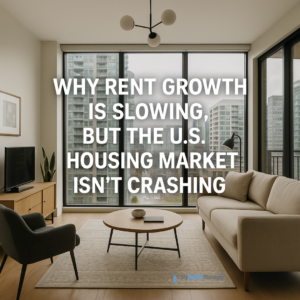Despite economic headwinds, the U.S. multifamily rental market continues to show resilience not booming like in past years, but steadily growing at a moderate, more sustainable pace. Recent trends reveal that rent growth has slowed, but not reversed, signaling a period of stabilization rather than a downturn. This balancing act between high supply and steady demand is shaping the next chapter for property owners, renters, and investors alike.
National Rent Growth Holds Ground Despite Slowdown
According to a recent report by Multifamily Dive, the national average rent climbed by $5 in April 2025, bringing the total to $1,736. While this increase may appear modest, it’s notable given the challenging economic backdrop.
-
Year-over-year rent growth: 0.9%, slightly lower than previous months.
-
Northeast & Midwest metros continue to lead, with New York City recording a strong 5.8% YOY.
-
Sun Belt metros, once the hottest rental markets in the nation, are cooling off:
-
Austin: –5.6%
-
Denver: –3.9%
-
Phoenix: –3.1%
-
Dallas & Orlando: –2.1%
-
This stark contrast underscores an important trend: rental performance is no longer universal. Instead, it’s increasingly shaped by regional economic conditions, supply pipelines, and migration patterns.
Why the Market Has Shifted to Moderate Growth
1. High Levels of New Construction Meet Steady Demand
The U.S. is currently experiencing one of its largest waves of new apartment deliveries in decades. This surge in supply has applied downward pressure on rent growth. However, absorption has remained remarkably stable due to:
-
Solid job growth in many metros
-
High mortgage rates that keep potential homebuyers in the rental pool
-
Elevated housing costs making homeownership less accessible
-
Existing home sales falling nearly 6% in March signaling affordability challenges for buyers
Despite new units hitting the market, many renters are staying put, and vacancy levels, while rising, are not spiking dramatically.
2. Vacancy Rates Are Rising, But Still Manageable
The national occupancy rate dipped to 94.4%, the lowest in over a decade. While this might raise concerns, it’s important to note:
-
Historically, 93–95% occupancy is considered healthy in the multifamily industry.
-
Markets with the biggest dips such as Austin, Dallas, and Phoenix are also the ones with the most aggressive construction pipelines.
-
Demand remains solid, but renters have more choices, which softens landlords’ ability to push rents aggressively.
This shift favors renter bargaining power in oversupplied submarkets while maintaining stability in more balanced regions.
3. Pipeline Is Shrinking Future Supply Could Tighten
Although supply is high today, developers are already pulling back on future projects. The report projects that completions could fall by 31% in 2026 and 43% by 2027. That means:
-
Rent pressures could ease in the short term but
-
Tightening supply could reignite rent growth in the medium term, particularly in high-demand metros.
This cyclical supply-demand dynamic is a key driver for investors and asset managers when making long-term decisions.
4. Macro Headwinds Add a Layer of Uncertainty
Beyond local market fundamentals, the broader economy plays a crucial role in shaping rent growth trajectories. Several macroeconomic factors are in play:
-
Tariff and trade policies especially under the Trump administration pose risks to overall economic growth.
-
The first-quarter GDP contraction has raised the possibility of a mild recession.
-
Consumer sentiment remains cautious, impacting household formation and mobility.
If the economy softens, some markets could see rent growth flatten or even turn slightly negativees pecially in overbuilt metros.
Projections: Slow and Steady Through 2025, Rebound Later
Yardi’s modeling forecasts a base case of 1.5% rent growth for 2025. Under a stable economic environment:
-
Growth may plateau or dip slightly in the short term
-
A rebound to 3%–4% annual growth is projected between 2027 and 2030
However, if macroeconomic risks intensify, the recovery could be delayed. The path forward is closely tied to interest rates, inflation trends, and the trajectory of the U.S. economy.
What This Means for Different Stakeholders
For Property Owners and Operators
-
Rethink rent increase strategies – Overly aggressive hikes may lead to higher turnover in competitive submarkets.
-
Focus on retention – Renewals and tenant satisfaction can offset the impact of slower leasing velocity.
-
CapEx and operational efficiency will play bigger roles in maintaining NOI during periods of slower growth.
For Renters
-
Greater negotiating power in oversupplied metros.
-
Opportunities to shop around for better deals, especially in markets with high vacancy.
-
In contrast, renters in high-demand cities like New York may continue to face upward pricing pressure.
For Investors and Developers
-
Short-term caution is warranted, but the long-term fundamentals remain attractive.
-
Well-located assets in resilient metros may outperform as supply tightens.
-
Timing new developments to coincide with the next demand wave could yield outsized returns.
The Big Picture
The U.S. rental market is not heading toward a crash it’s entering a more balanced phase. Rents are still growing, albeit at a slower pace, and fundamentals remain strong in many regions. With new construction starting to ease and demand remaining steady, this period of moderation may actually set the stage for a healthier, more sustainable market over the next several years.
Whether you’re a landlord, renter, or investor, the message is clear: be strategic, watch the data, and plan for a market that’s shifting from boom to balance.
Source: Moderate apartment rent growth continues amid economic uncertainty – Multifamily Dive

